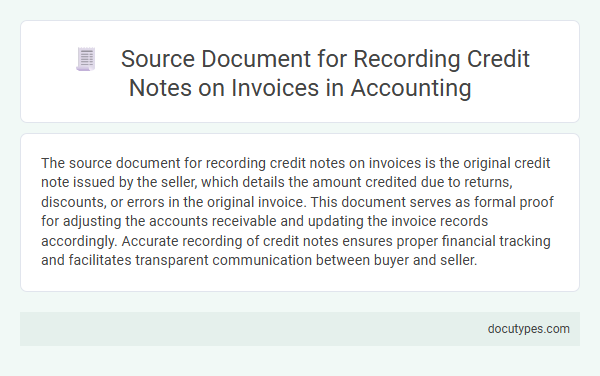The source document for recording credit notes on invoices is the original credit note issued by the seller, which details the amount credited due to returns, discounts, or errors in the original invoice. This document serves as formal proof for adjusting the accounts receivable and updating the invoice records accordingly. Accurate recording of credit notes ensures proper financial tracking and facilitates transparent communication between buyer and seller.
Introduction to Source Documents in Accounting
The source document for recording credit notes on invoices is the credit note itself, a formal document issued by a seller to a buyer, indicating a reduction in the amount owed. Source documents are essential in accounting as they provide verifiable evidence for all financial transactions, ensuring accuracy and accountability. Understanding the role of credit notes as source documents helps maintain the integrity of accounts receivable and supports proper financial reporting.
Understanding Credit Notes on Invoices
Understanding credit notes on invoices is essential for accurate financial record-keeping. The source document for recording credit notes ensures all adjustments to sales or returns are properly documented.
- Credit Note Definition - A credit note is an official document issued by a seller to a buyer, reducing the amount owed on an invoice due to returns, errors, or discounts.
- Source Document Role - The credit note itself serves as the primary source document for recording adjustments against original invoices in accounting systems.
- Recording Process - Businesses use credit notes to update their accounts receivable and inventory records, reflecting accurate financial positions and customer balances.
The Role of Source Documents in Credit Note Processing
| Topic | The Role of Source Documents in Credit Note Processing |
|---|---|
| Definition | Source documents are original records that provide evidence for accounting transactions, including credit notes issued against invoices. |
| Primary Source Document for Credit Notes | Credit Note itself is the main source document used to record adjustments made to invoices, reflecting returns, discounts, or billing errors. |
| Purpose of Source Documents |
|
| Process Involvement | Source documents support the credit note approval process, ensuring that adjustments to invoices are legitimate and properly authorized before recording in accounting systems. |
| Accounting Impact | Source documents enable precise entry of credit notes into ledgers, reducing discrepancies in invoicing records and improving overall financial transparency. |
Types of Source Documents for Credit Notes
What is the source document for recording credit notes on invoices? The source document for credit notes typically includes credit note forms, return authorizations, and refund receipts. These documents provide essential details to accurately adjust the original invoice in your accounting records.
Key Information Included in Credit Note Source Documents
The source document for recording credit notes on invoices is the credit note itself, which serves as official proof of a reduction in the amount owed by the customer. It references the original invoice and details the reason for the credit, such as returned goods or billing errors.
Key information included in credit note source documents involves the credit note number, date of issuance, and the customer's details. It specifies the original invoice number to maintain a link between the documents. The document also clearly describes the quantity and value of returned items or adjustments, ensuring accurate accounting records.
Procedures for Recording Credit Notes Using Source Documents
The source document for recording credit notes on invoices is typically the credit note itself, which acts as proof of the reduction in the amount payable by the customer. This document includes details such as the original invoice number, the reason for the credit, and the value of the credit issued.
To record credit notes accurately, you should first match the credit note with the corresponding invoice in the accounting system. Enter the credit note details into your ledger to adjust the outstanding balance and maintain precise financial records.
Importance of Accurate Source Documentation for Credit Notes
The source document for recording credit notes on invoices is typically the credit note itself, which provides essential details for transaction adjustments. Accurate source documentation ensures the validity and traceability of all financial records involving credit notes.
- Legal Compliance - Maintaining precise source documents supports adherence to tax regulations and auditing standards.
- Financial Accuracy - Correct documentation prevents errors in account balances and revenue reporting.
- Dispute Resolution - Clear credit note records help resolve discrepancies between sellers and buyers efficiently.
Internal Controls for Managing Credit Note Source Documents
The source document for recording credit notes on invoices is the credit note itself, which serves as official evidence of a reduction in the amount owed by the customer. Proper internal controls ensure the authenticity, accuracy, and authorization of credit note transactions within the accounting system.
- Authorization Controls - Credit notes must be approved by designated personnel before recording to prevent unauthorized adjustments.
- Documentation and Traceability - Maintaining original credit note documents linked to the corresponding invoice ensures clear audit trails.
- Segregation of Duties - Separate responsibilities for issuing, recording, and approving credit notes reduce the risk of fraud and errors.
Effective internal controls over credit note source documents enhance financial accuracy and support compliance with accounting standards.
Compliance and Audit Considerations for Credit Note Documentation
The source document for recording credit notes on invoices is the original credit note issued by the seller. This document must clearly state the reason for the credit, reference the original invoice number, and include the date of issuance to ensure proper tracking.
Compliance with accounting standards and tax regulations requires maintaining accurate and complete credit note documentation. Auditors rely on these documents to verify adjustments and validate financial records during audits, ensuring transparency and accountability in your financial processes.
What Is the Source Document for Recording Credit Notes on Invoices? Infographic

